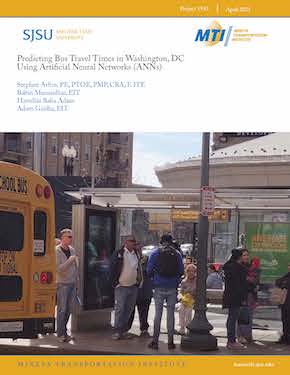- 408-924-7560
- mineta-institute@sjsu.edu
- Donate
Predicting Bus Travel Times in Washington, DC Using Artificial Neural Networks (ANNs)
Washington, DC is ranked second among cities in terms of highest public transit commuters in the United States, with approximately 9% of the working population using the Washington Metropolitan Area Transit Authority (WMATA) Metrobuses to commute. Deducing accurate travel times of these metrobuses is an important task for transit authorities to provide reliable service to its patrons. This study, using Artificial Neural Networks (ANN), developed prediction models for transit buses to assist decision-makers to improve service quality and patronage. For this study, we used six months of Automatic Vehicle Location (AVL) and Automatic Passenger Counting (APC) data for six Washington Metropolitan Area Transit Authority (WMATA) bus routes operating in Washington, DC. We developed regression models and Artificial Neural Network (ANN) models for predicting travel times of buses for different peak periods (AM, Mid-Day and PM). Our analysis included variables such as number of served bus stops, length of route between bus stops, average number of passengers in the bus, average dwell time of buses, and number of intersections between bus stops. We obtained ANN models for travel times by using approximation technique incorporating two separate algorithms: Quasi-Newton and Levenberg-Marquardt. The training strategy for neural network models involved feed forward and errorback processes that minimized the generated errors. We also evaluated the models with a Comparison of the Normalized Squared Errors (NSE). From the results, we observed that the travel times of buses and the dwell times at bus stops generally increased over time of the day. We gathered travel time equations for buses for the AM, Mid-Day and PM Peaks. The lowest NSE for the AM, Mid-Day and PM Peak periods corresponded to training processes using Quasi-Newton algorithm, which had 3, 2 and 5 perceptron layers, respectively. These prediction models could be adapted by transit agencies to provide the patrons with accurate travel time information at bus stops or online.
STEPHEN ARHIN, PhD, P.E., PTOE, PMP, CRA, Fellow ITE
Dr. Stephen Arhin is an Associate Professor in the Civil and Environmental Engineering Department at Howard University. He has more than 25 years of experience in all facets of traffic and transportation engineering. He is a registered Professional Engineer (P.E.) in DC, DE, MD, and VA, and a registered Professional Traffic Operations Engineer (PTOE). He is also a Certified Research Administrator (CRA), a certified Project Management Professional (PMP) and a Fellow of the Institute of Transportation Engineers (ITE). He has extensive experience in working with state and local transportation agencies on a wide variety of safety, operations, and design projects in addition to private industry. Dr. Arhin has authored and co-authored several project reports, published articles in peer-reviewed journals and presented at conferences on such topics as pedestrian and bicycle safety, countdown pedestrian traffic signals, intelligent transportation technologies, pavement condition monitoring, crash data analysis, traffic volume trends, mitigation of reflective cracking in composite highway pavements, truck weight enforcement and red-light violation. He is a member of ITE, TRB and ASCE, and serves as a Program Evaluator for ABET.
BABIN MANANDHAR, EIT
Babin Manandhar is an Engineer in Training (EIT) and a research assistant at the Howard University Transportation Research and Data Center. He has a Master of Engineering degree in Civil and Environmental Engineering from Howard University.
ADAM GATIBA, EIT
Adam Gatiba is a research assistant at the Howard University Transportation Research Center. He has a Master of Science degree in Civil Engineering from Howard University. Adam also works at Volkert Inc. as a Traffic Engineer with focus on traffic safety and operations.
HAMDIAT BABA ADAM
Hamdiat Baba Adam holds a Master of Science degree in Geospatial Information Sciences
(GIS) from the University of Maryland. She has Geomatic Engineering experience in the Transportation and Energy Industry. Hamdiat is currently a Research Assistant at the Howard University Transportation Research Center.
-
Contact Us
San José State University One Washington Square, San Jose, CA 95192 Phone: 408-924-7560 Email: mineta-institute@sjsu.edu






